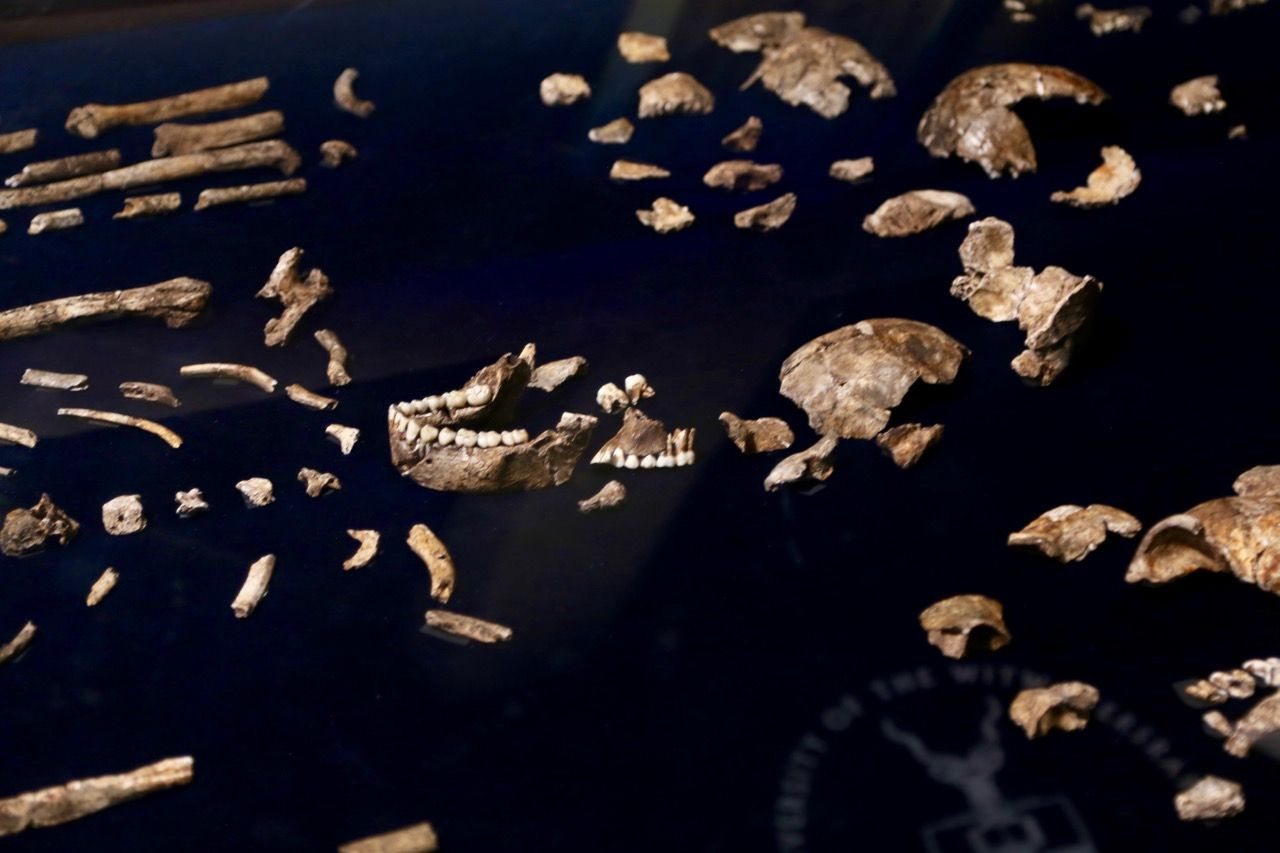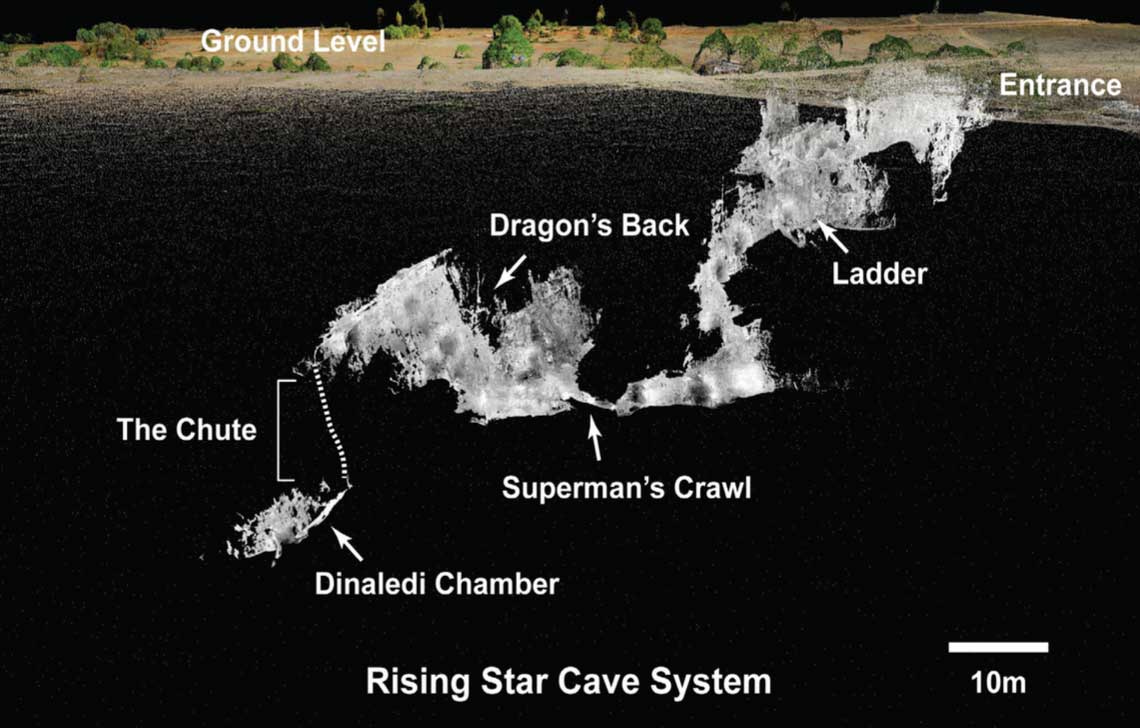Looking at the hypothesis of deliberate deposition for Homo naledi
An exchange of views in the Journal of Human Evolution includes an examination of evidence about how skeletons ended up in the Dinaledi Chamber.
Note: This post was written in 2016. Subsequent research has established significantly more detail about the burial situation of H. naledi remains in the Dinaledi Subystem of the Rising Star cave system. This work is covered in later posts. The current post has been left in its original form as an accurate reflection of the state of research at the time it was written.
Earlier this spring, the Journal of Human Evolution published a commentary questioning our team’s interpretation of taphonomic evidence from the Dinaledi Chamber. In the commentary, Aurore Val suggested that the evidence does not rule out some involvement of carnivores as accumulators of the Dinaledi hominin assemblage, and that parts of hominin skeletons may have been transported from a more accessible location by gravity or water.
Our reply was just entered into the “corrected proofs” online access to the journal today. In the reply, we provide a brief summary of the evidence, emphasizing the data that exclude any direct access to the chamber from the outside environment, exclude post-depositional transport of the hominin remains, and exclude carnivore involvement. As we emphasize in our reply, we do not claim any proof of the hypothesis of deliberate deposition of the hominin remains, but the evidence so far excludes other hypotheses that work for other cave assemblages in South Africa.
In conversations with colleagues during the past several months, I’ve been struck by how interested people are in the layout of the Rising Star cave system and the potential for alternative scenarios for the deposition of the fossil remains. People have really been amazingly creative in thinking about how to get 15 hominin bodies into a remote chamber of a cave.
Obviously our team began with many of the same questions, and we all share the perspective that we just want to find the best answers without any preconception as to what they will be. As more and more specialists became involved, each brought their own expertise to bear on the taphonomy of the remains and the geochemistry and geology of the cave. The research is truly interdisciplinary and understandably that can make it hard even for experienced scientists outside the research to follow, because some of the critical areas of evidence have to do with sediment geochemistry, invertebrate modifications on bone surfaces, and the effects of groundwater on unconsolidated sediment fills. Personally, I’ve learned more about cave snails than I ever expected to know.
Here’s a short excerpt:
H. naledi is a newly-discovered species and we consider it unwise to adopt any prior assumptions about its behavioral repertoire. Although living non-human apes do not cache bodies, they do exhibit emotional, cognitive and social prerequisites of such behaviors (Pettitt, 2011). The closest living relative of H. naledi is our own species, which exhibits elaborate mortuary behavior in every culture. Evidence of body deposition in H. naledi merely extends a behavior already observed in archaic and pre-modern humans (Formicola and Buzhilova, 2004; Carbonell and Mosquera, 2006; Pettitt, 2011; Geiling and Marín-Arroyo, 2015) to a deeper node of our phylogenetic history. The geological age of the assemblage is presently not known, but is irrelevant to interpretation of this behavior.
The great news about our research is that more results keep coming in, and the team is developing a better and better understanding of the Rising Star cave system. For example, last month Ashley Kruger and colleagues published a great paper reviewing the team’s 3-D data collection strategies, with a new laser survey map of the present route to the Dinaledi Chamber. Our original research article on the context of the fossil assemblage remains open access in eLife, with detailed maps and analyses.
People who attended the symposium on the Homo naledi research at the AAPA meetings earlier this spring got a good perspective on the kinds of research we are doing to uncover more about the context of the fossil remains, and more work will be coming out in upcoming months. In the meantime, I hope people find our reply helpful in working through the basic evidence that constrains hypotheses about deposition of remains in the Dinaledi Chamber.
References
Dirks, P. H., Berger, L. R., Roberts, E. M., Kramers, J. D., Hawks, J., Randolph-Quinney, P. S., Elliott, M., Musiba, C. M., Churchill, S. E., de Ruiter, D. J., Schmid, P., Backwell, L. R., Belyanin, G. A., Boshoff, P., Hunter, K. L., Feuerriegel, E. M., Gurtov, A., Harrison, J. du G., Hunter, R., … Tucker, S. (2015). Geological and taphonomic context for the new hominin species Homo naledi from the Dinaledi Chamber, South Africa. eLife, 4, e09561. https://doi.org/10.7554/eLife.09561
Dirks, P. H. G. M., Berger, L. R., Hawks, J., Randolph-Quinney, P. S., Backwell, L. R., & Roberts, E. M. (2016). Comment on “Deliberate body disposal by hominins in the Dinaledi Chamber, Cradle of Humankind, South Africa?” [J. Hum. Evol. 96 (2016) 145–148]. Journal of Human Evolution, 96, 149–153. https://doi.org/10.1016/j.jhevol.2016.04.007
Kruger, A. (2017). Site formation processes at Rising Star: Taphonomy and 3D spatial analyses of the Homo naledi assemblage [PhD, University of the Witwatersrand]. http://hdl.handle.net/10539/23510
Val, A. (2016). Deliberate body disposal by hominins in the Dinaledi Chamber, Cradle of Humankind, South Africa? Journal of Human Evolution, 96, 145–148. https://doi.org/10.1016/j.jhevol.2016.02.004





